#Liberty Square Novi Sad
Photo

THE BOOK OF TOBIAS Or Tobit* - From The Douay-Rheims Bible - Latin Vulgate
Chapter 10
INTRODUCTION.
This Book takes its name from the holy man Tobias, whose wonderful virtues are herein recorded. It contains most excellent documents of great piety, extraordinary patience, and of perfect resignation to the will of God. His humble prayer was heard, and the angel Raphael was sent to relieve him: he is thankful, and praises the Lord, calling on the children of Israel to do the same. Having lived to the age of one hundred and two years, he exhorts his son and grandsons to piety, foretells the destruction of Ninive, and the rebuilding of Jerusalem: he dies happily. Ch. --- The Jews themselves have a great regard for the book of Tobias; (Grot. Sixtus Senens. viii.) which Origen (ad Afric.) says they "read in Hebrew," meaning probably the Chaldee, (C.) out of which language S. Jerom translated it, preferring to displease the Pharisaical Jews, rather than not to satisfy the desires of the holy bishops Chromatius and Heliodorus. Ep. t. iii. W. --- The Greek version seems to have been taken from another copy, or it has been executed with greater liberty by the Hellenist Jews, between the times of the Sept. and of Theodotion. C. --- Huet and Prideaux esteem it more original; and Houbigant has translated it in his Bible, as the Council of Trent only spoke of the Latin editions then extant; and S. Jerom followed in his version the Hebrew one of a Jew, as he did not understand the Chaldee. H. --- The Syriac and the modern Hebrew edition of Fagius, agree mostly with the Greek, as that of Munster and another Heb. copy of Huet, and the Arabic version, both unpublished, are more conformable to the Vulgate. The most ancient Latin version used before S. Jerom, was taken from the Greek; and the Fathers who lived in those ages, speak of it when they call the book of Tobias canonical. S. Aug. leaves it, however, to adopt S. Jerom's version, in his Mirrour. The copies of all these versions vary greatly, (C.) though the substance of the history is still the same; and in all we discover the virtues of a good parent, of a dutiful son, and virtuous husband, beautifully described. H. --- "The servant of God, holy Tobias, is given to us after the law for an example, that we might know how to practise what we read; and that if temptations assail us, we may not depart from the fear of God, nor expect help from any other." S. Aug. q. 119. ex utroque Test. --- The four first chapters exhibit the holy life of old Tobias, and the eight following, the journey and affairs of his son, directed by Raphael. In the two last chapters they praise God, and the elder Tobias foretells the better state of the commonwealth. W. --- It is probable that both left records, from which this work has been compiled, with a few additional observations. It was written during (C.) or after the captivity of Babylon. E. --- The Jews had then little communication with each other, in different kingdoms. Tobias was not allowed to go into Media, under Sennacherib; and it is probable that the captives at Babylon would be under similar restrictions; so that we do not need to wonder that they were unacquainted with this history of a private family, the records of which seem to have been kept at Ecbatana. The original Chaldee is entirely lost, so that it is impossible to ascertain whether the Greek or the Vulg. be more conformable to it. The chronology of the latter seems however more accurate, as the elder Tobias foretold the destruction of Ninive, twenty-three years before the event, which his son just beheld verified, dying in the 18th year of king Josias. The accounts which appear to sectaries to be fabulous, may easily be explained. Houbigant. --- Josephus and Philo omit this history. C.
* One of the seven Deutero-Canonical books, missing from most non-Catholic Bibles.
The additional Notes in this Edition of the New Testament will be marked with the letter A. Such as are taken from various Interpreters and Commentators, will be marked as in the Old Testament. B. Bristow, C. Calmet, Ch. Challoner, D. Du Hamel, E. Estius, J. Jansenius, M. Menochius, Po. Polus, P. Pastorini, T. Tirinus, V. Bible de Vence, W. Worthington, Wi. Witham. — The names of other authors, who may be occasionally consulted, will be given at full length.
Verses are in English and Latin. HAYDOCK CATHOLIC BIBLE COMMENTARY
This Catholic commentary on the Old Testament, following the Douay-Rheims Bible text, was originally compiled by Catholic priest and biblical scholar Rev. George Leo Haydock (1774-1849). This transcription is based on Haydock's notes as they appear in the 1859 edition of Haydock's Catholic Family Bible and Commentary printed by Edward Dunigan and Brother, New York, New York.
TRANSCRIBER'S NOTES
Changes made to the original text for this transcription include the following:
Greek letters. The original text sometimes includes Greek expressions spelled out in Greek letters. In this transcription, those expressions have been transliterated from Greek letters to English letters, put in italics, and underlined. The following substitution scheme has been used: A for Alpha; B for Beta; G for Gamma; D for Delta; E for Epsilon; Z for Zeta; E for Eta; Th for Theta; I for Iota; K for Kappa; L for Lamda; M for Mu; N for Nu; X for Xi; O for Omicron; P for Pi; R for Rho; S for Sigma; T for Tau; U for Upsilon; Ph for Phi; Ch for Chi; Ps for Psi; O for Omega. For example, where the name, Jesus, is spelled out in the original text in Greek letters, Iota-eta-sigma-omicron-upsilon-sigma, it is transliterated in this transcription as, Iesous. Greek diacritical marks have not been represented in this transcription.
Footnotes. The original text indicates footnotes with special characters, including the astrisk (*) and printers' marks, such as the dagger mark, the double dagger mark, the section mark, the parallels mark, and the paragraph mark. In this transcription all these special characters have been replaced by numbers in square brackets, such as [1], [2], [3], etc.
Accent marks. The original text contains some English letters represented with accent marks. In this transcription, those letters have been rendered in this transcription without their accent marks.
Other special characters.
Solid horizontal lines of various lengths that appear in the original text have been represented as a series of consecutive hyphens of approximately the same length, such as ---.
Ligatures, single characters containing two letters united, in the original text in some Latin expressions have been represented in this transcription as separate letters. The ligature formed by uniting A and E is represented as Ae, that of a and e as ae, that of O and E as Oe, and that of o and e as oe.
Monetary sums in the original text represented with a preceding British pound sterling symbol (a stylized L, transected by a short horizontal line) are represented in this transcription with a following pound symbol, l.
The half symbol (1/2) and three-quarters symbol (3/4) in the original text have been represented in this transcription with their decimal equivalent, (.5) and (.75) respectively.
Unreadable text. Places where the transcriber's copy of the original text is unreadable have been indicated in this transcription by an empty set of square brackets, [].
Chapter 10
The parents lament the long absence of their son Tobias. He sets out to return.
[1] But as Tobias made longer stay upon occasion of the marriage, Tobias his father was solicitous, saying: Why thinkest thou doth my son tarry, or why is he detained there?
Cum vero moras faceret Tobias, causa nuptiarum, sollicitus erat pater ejus Tobias, dicens : Putas quare moratur filius meus, aut quare detentus est ibi?
[2] Is Gabelus dead, thinkest thou, and no man will pay him the money?
Putasne Gabelus mortuus est, et nemo reddet illi pecuniam?
[3] And he began to be exceeding sad, both he and Anna his wife with him: and they began both to weep together: because their son did not return to them on the day appointed.
Coepit autem contristari nimis ipse et Anna uxor ejus cum eo : et coeperunt ambo simul flere : eo quod die statuto minime reverteretur filius eorum ad eos.
[4] But his mother wept and was quite disconsolate, and said: Woe, woe is me, my son; why did we send thee to go to a strange country, the light of our eyes, the staff of our old age, the comfort of our life, the hope of our posterity?
Flebat igitur mater ejus irremediabilibus lacrimis, atque dicebat : Heu, heu me, fili mi! ut quid te misimus peregrinari, lumen oculorum nostrorum, baculum senectutis nostrae, solatium vitae nostrae, spem posteritatis nostrae?
[5] We having all things together in thee alone, ought not to have let thee go from us.
omnia simul in te uno habentes, te non debuimus dimittere a nobis.
[6] And Tobias said to her: Hold thy peace, and be not troubled, our son is safe: that man with whom we sent him is very trusty.
Cui dicebat Tobias : Tace, et noli turbari : sanus est filius noster : satis fidelis est vir ille, cum quo misimus eum.
[7] But she could by no means be comforted, but daily running out looked round about, and went into all the ways by which there seemed any hope he might return, that she might if possible see him coming afar off.
Illa autem nullo modo consolari poterat, sed quotidie exiliens circumspiciebat, et circuibat vias omnes, per quas spes remeandi videbatur, ut procul videret eum, si fieri posset, venientem.
[8] But Raguel said to his son in law: Stay here, and I will send a messenger to Tobias thy father, that thou art in health.
At vero Raguel dicebat ad generum suum : Mane hic, et ego mittam nuntium salutis de te ad Tobiam patrem tuum.
[9] And Tobias said to him: I know that my father and mother now count the days, and their spirit is grievously afflicted within them.
Cui Tobias ait : Ego novi quia pater meus et mater mea modo dies computant, et cruciatur spiritus eorum in ipsis.
[10] And when Raguel had pressed Tobias with many words, and he by no means would hearken to him, he delivered Sara unto him, and half of all his substance in menservants, and womenservants, in cattle, in camels, and in kine, and in much money, and sent him away safe and joyful from him.
Cumque verbis multis rogaret Raguel Tobiam, et ille eum nulla ratione vellet audire, tradidit ei Saram, et dimidiam partem omnis substantiae suae in pueris, in puellis, in pecudibus, in camelis, et in vaccis, et in pecunia multa : et salvum atque gaudentem dimisit eum a se,
[11] Saying: The holy angel of the Lord be with you in your journey, and bring you through safe, and that you may find all things well about your parents, and my eyes see your children before I die.
dicens : Angelus Domini sanctus sit in itinere vestro, perducatque vos incolumes, et inveniatis omnia recte circa parentes vestros, et videant oculi mei filios vestros priusquam moriar.
[12] And the parents taking their daughter kissed her, and let her go:
Et apprehendentes parentes filiam suam, osculati sunt eam : et dimiserunt ire,
[13] Admonishing her to honour her father and mother in law, to love her husband, to take care of the family, to govern the house, and to behave herself irreprehensibly.
monentes eam honorare soceros, diligere maritum, regere familiam, gubernare domum, et seipsam irreprehensibilem exhibere.
Commentary:
Ver. 1. But. Gr. "And Tobit, his father, counted each day; and as the days of the journey were ended, and they did not come, Tobit said, Is he not put to shame?" (H.) and refused payment? C. --- Old Vulg. and Prot. "detained."
Ver. 3. He. Gr. "He was much troubled. But his wife said to him, the boy is come to an untimely end, since he tarries; and she began to mourn for him, and said, I am not, or am I not full of solicitude, my son, that I have let thee go, the light of my eyes and Tobit ?", v. 6. Without this interrogation, (H.) the Gr. seems to be corrupt; (C.) and wV, "how," or oi, "woe," should be put instead of ou, "not." Drus. Grot. &c. "Now I care for nothing, my son, since I have let thee go, the light," &c. Prot.
Ver. 6. That. Gr. "and she said to him, Be silent, deceive me not. My son is lost: and she went out daily into the road without, by which they departed. In the day time she eat no bread, and the night she spent in bewailing her son, Tobias, till the 14 days of the wedding were finished, which Raguel had adjured him to tarry there. And," v. 9. H. --- Thus the converted Jews lament that Christ should so long abandon their nation, while some hope like Tobias, and others are in more suspense, like his wife. V. Bede. --- So Catholics, in countries fallen into heresy, are in great distress for their brethren; (Rom. ix.) While some more confidently hope that God will enlighten our nation again, as sight was restored to old Tobias. W.
Ver. 8. Raguel. Gr. "Tobias," as v. 9, which is transposed.
Ver. 9. Days. It would require 42, (T.) or 38, (Torniel) or 34 days, (Salien. M.) to perform what is here recorded. H. --- But it would be difficult to ascertain the precise time. To go from Ninive to Ecbatana would occupy eight or ten days. C. ---If, therefore, the parents of Tobias expected that he would return in about 20 days, they might well wonder at the 14 days’ delay occasioned by the marriage. The distance might prevent him from giving notice of this event. Gr. "Dismiss me, because my, &c....no longer hope to see me again. But his father-in-law replied, Stop with me," &c. v. 8. H.
Ver. 10. When. Gr. "And Tobias said, No; but dismiss me to my father and mother. Then Raguel rising up, gave him Sarra, his wife, and half his goods, bodies, beasts, and silver." This expression, bodies, (H). or men generally denotes slaves; but it may also be put for others, (C.) who were in the train of Sara. Grot. --- Safe. Gr. "with blessing, saying, May God prosper you, children, the God of heaven, before I die; and he said to his daughter, Honour thy father and mother-in-law, they are now thy parents. May I hear a good report of thee, and he kissed her; and Edna said to Tobias, dear brother, May the Lord of heaven re-establish thee and grant me to behold thy children by my daughter, Sarra, that I may rejoice before the Lord; and behold, I place my daughter with thee as a deposit, and thou must not grieve her. Afterwards she departed, and Toby also blessing God, and he made his journey prosperous and blessed. Raguel, and Edna, and his wife." H. --- The Jews still adopt many customs similar to those which we here behold, as this is a most excellent description of a holy marriage. Serarius. C. - Some also prevail in the Christian Church, though marriage is now become more holy, and a sacrament. Cat. Rom. q. 22. - The proper intent of the contract, and many rites accompanying it, may be seen in the preceding chapters. W.
1 note
·
View note
Text
Novi Sad, Serbia
Novi Sad is the second largest city in Serbia after Belgrade, famous for its Exit festival. It is on the banks of the Danube River and is absolutely gorgeous to the point that if there were such competition as being the most beautiful city in Serbia, it would give a very healthy competition to Belgrade. Being only 58 miles/94 Km from Belgrade, it makes a perfect day trip from Belgrade, though spending a night or two would be good too.
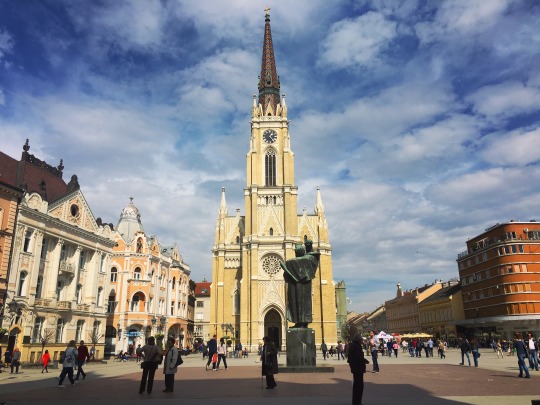
The city center of Novi Sad
History of Novi Sad
Novi Sad was founded in 1694 by Serb merchants across the Danube from the Petrovaradin fortress, during the reign of Habsburg empire as people of Orthodox faith were forbidden in Petrovaradin. So, they had to come up with something to survive and hence they found Novi Sad. During 18th and 19th century, Novi Sad was the largest city with ethnic serbs population in the world. During the revolution of 1848-1849, Hungarian army destroyed Novi Sad to a great extent leading to decrease in the population of Serbs and increase in the population of Hungarians. After WW1, when Austro-Hungarian empire ended, the city was taken by the Serb National Board and the Serb Safeguard. There was destruction of the city during the WW2 and people lost their lives fighting the Axis power. More recently, due to the bombardment by NATO during the Kosovo war of 1999, once again the city had to suffer. Nevertheless, right now Novi Sad is a happening city which is also 2019’s European Youth Capital.
How to reach Novi Sad from Belgrade
You can easily reach Novi Sad from Belgrade and vice versa. It takes about 1.5 hours by bus to reach. We took a bus leaving at 11 AM from Belgrade bus station, which is close to the city center. We bought our tickets from inside the bus station easily. Make sure you bring cash as they don’t accept credit card. There is an ATM on the other side of the bus station. You can find the schedule of buses leaving to and from Novi Sad here. You don’t have to worry if you miss your bus because there are buses every 15 minutes and it costs about 450-500 dinar one way.
You can also reach Novi Sad by train (train station is close to bus station) though I have heard trains usually run late in Serbia, but one advantage is it would cost you almost half than bus. You can find the schedule of trains here. It takes 1.5-2 hours by train to reach if train is not late.
If you decide to drive, it would take you only about an hour to reach Novi Sad.
Novi Sad bus/railway station is not super close to the old town. We walked and it took us about half an hour to reach and since we love walking, we were fine. In case, you are not up for walking, you can take bus number 3/4/11.
Attractions in Novi Sad
1. Trg Slobode (Liberty Square) or Old Town Square
If you are in Novi Sad for the first time, this is where you should start from. Trg Slobode is the Old Town square built in the 18th century This square is just so lovely and full of people. It is a common gathering point for locals, and concerts are held here too. You can always find someone taking pictures in the square because it is so goddamn beautiful.
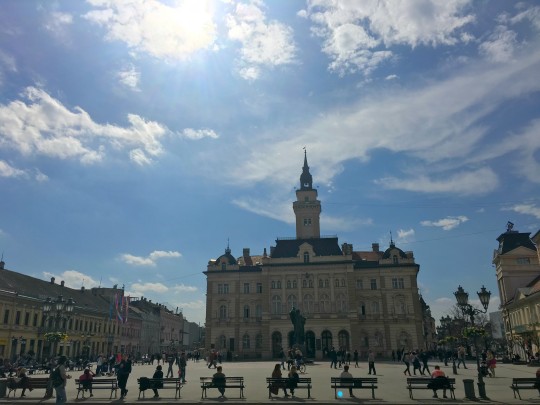
Trg Slobode (Liberty Square) or Old Town Square
Right in the middle you see the statue of Svetozar Miletić in bronze by Ivan Meštrović, who was Croatia’s or you can say ex Yugoslavia’s most renowned sculptor. Svetozar Miletić was a lawyer and mayor of Novi Sad and one of the most influential Serbians.
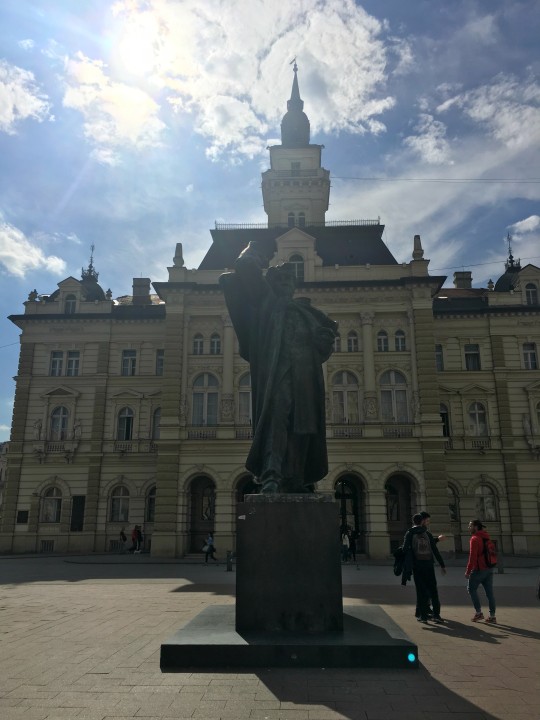
The monument to Svetozar Miletić. Sorry my picture is not clear as it was too much sun that day.
Behind the statue of Svetozar Miletić, there is a neo-Renaissance building of city hall built in 1894.Right now, it is the head office of the mayor and city council.
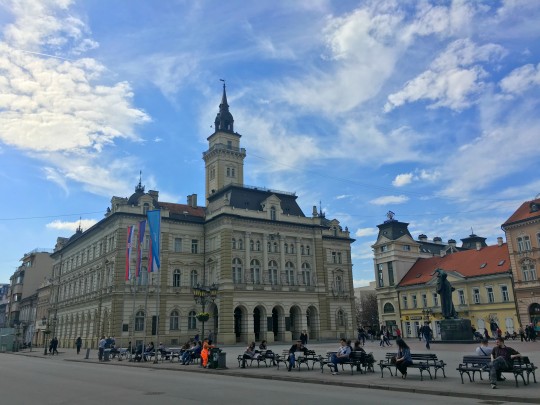
The City Hall of Novi Sad
2. Old Town
In the vicinity of the Old Town Square, you find the vibrant Old Town of Novi Sad, beaming up with cafes, restaurants, clothing stores, souvenir shops, and of course tons of people talking, gossiping, laughing, taking pictures, eating, etc.

Zmaj Jovina street, one of the oldest streets in Novi Sad
Zmaj Jovina street extends from Liberty Square to the bishop's palace. At the end of the street, there is a monument of Jovan Jovanovic Zmaj, who was famous for poems for children.

Monument of Jovan Jovanovic Zmaj
Turning right at the statue of Jovan Zmaj, you reach the Dunavska Street, which is the oldest street in Novi Sad, which leads to the Dunavski/Danube Park.
3. Dunavski Park/Danube Park
Dunavski Park is the oldest and most beautiful park in Novi Sad. It was built on swamp which was always flooded by Danube river and that’s how it got its name.

Danube park
When we visited, which was in March, it was crowded with locals. We saw a lot of kids with their parents and also many young couples walking hands in hands or just sitting down.
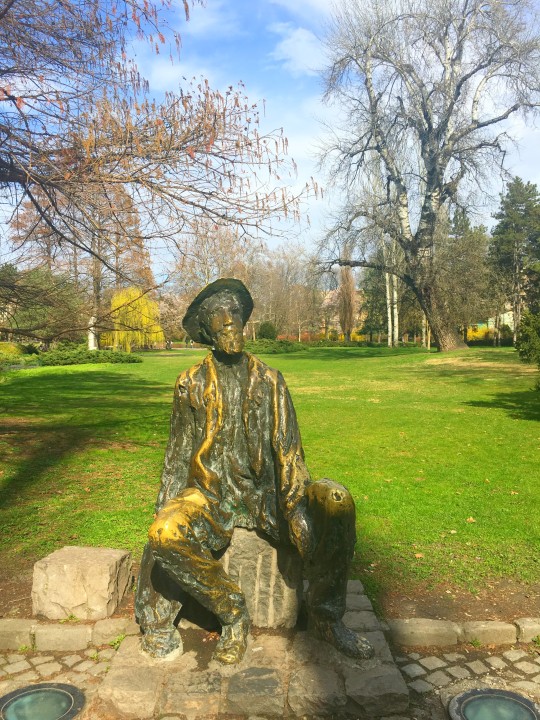
Monument of Đuri Jakšiću at Dunavski Park

Monument of Miroslav Antić at Dunavski Park
The star attraction of the old town of Novi Sad is a Roman catholic parish church called The Name of Mary Church. It is built in a typical Hungarian style. It is really tall and the architecture in neo-gothic. There are a lot of beautiful stained glasses depicting saints and holy fathers.

The Name of Mary Church
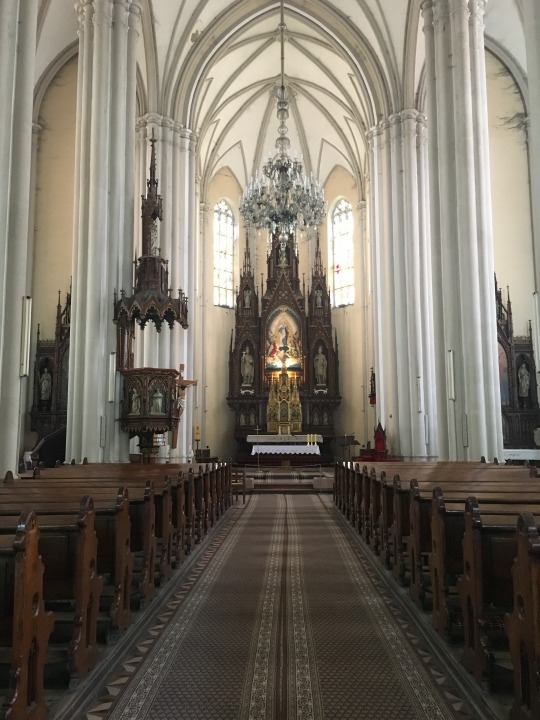
Interior of the church
4. Hotel Vojvodina
Hotel Vojvodina was built in 1854 for the owner Johan Eigler. It was earlier called Empress Elizabeth after the name of the wife of the Austrian emperor Franc Joseph. More than 60 meters in length, it has the longest facade in the old town.
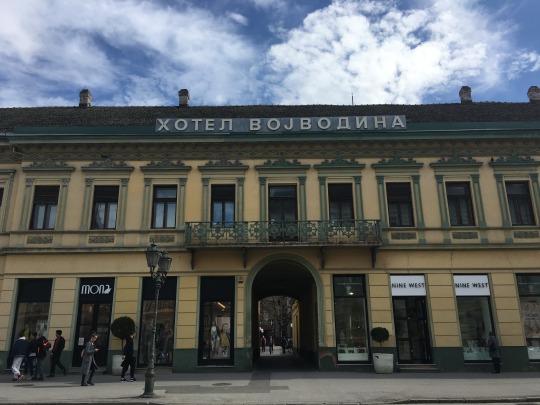
Hotel Vojvodina
5. Petrovaradin Fortress
Petrovaradin Fortress, which is inscribed on the UNESCO patrimony list is only half an hour walk from the city center of Novi Sad and let me tell you don’t let the distance prevent you from visiting it. On foot, you cross the bridge and the Danube river to reach. If you do not want to walk, you can take either bus # 3 or 9, which connects the centre and the Petrovaradin Fortress, on the right bank of the Danube.

Petrovaradin Fortress from one of the bridges in Novi Sad
Petrovaradin Fortress also known as the “Gibraltar of the Danube” is one of the most preserved fortresses. It was built by the Austrians. The construction started in 1692 and it took only 88 years to finish it. It extends to more than 110 hectares.
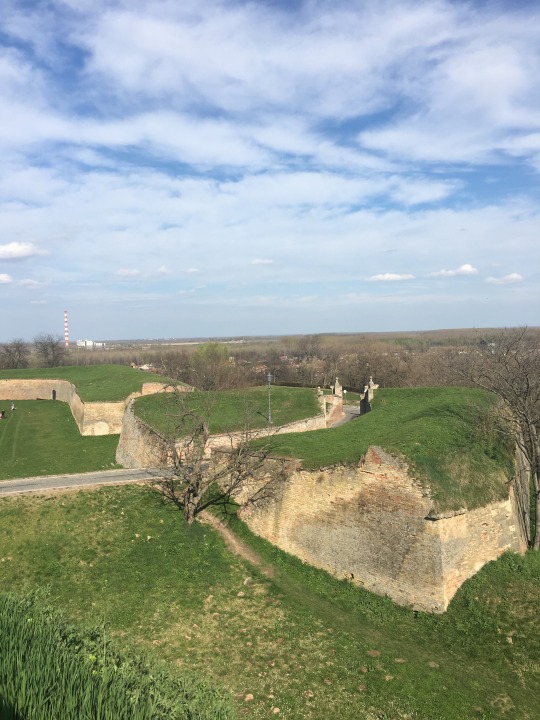
There are a lot of green areas in and around the fortress
If you wanna explore the whole fortress leisurely, it will take you atleast 2 hours. There are some cafes and restaurants inside and we saw locals relaxing and eating. Heard food is good but pricey.
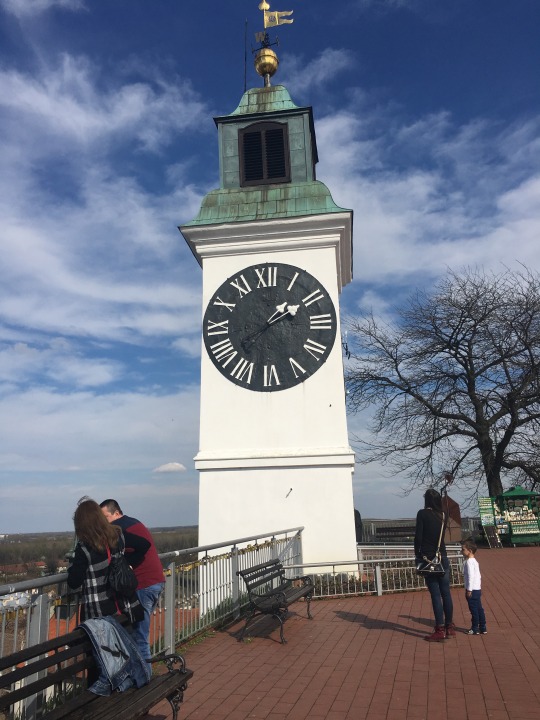
The clock tower on balcony
The view of Novi Sad over the Danube river is excellent. It's also a place where the big Exit festival is held every year.
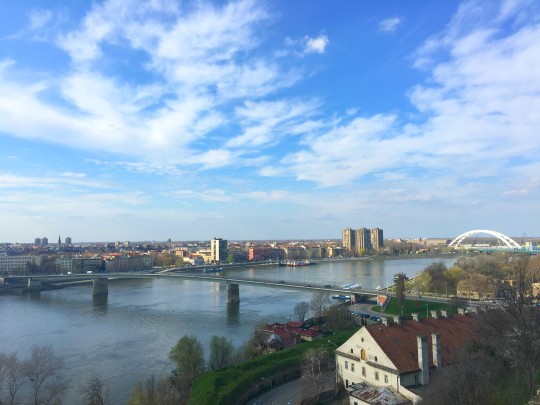
The view from the fortress
We took the bus back to Belgrade at 4 PM and made it by 5:30. Novi Sad should definitely be on your list if you visit Serbia. It is so convenient to reach from Belgrade and there are tons of things to do here and even if you don’t wanna do anything, you can just sit either at the Old Town Square or the Danube park or the fortress and have fun.
#novi sad#serbia#srbija#day trip from belgrade#yugoslavia#eastern european#travel#europe#traveling#travel blogger#travel blog#petrovaradin#church#danube#danube river#danube park#euro trip#balkan#austrian empire
0 notes